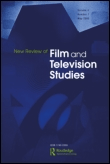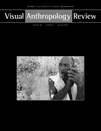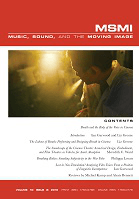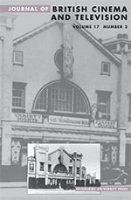
New Review of Film and Television Studies
Scope & Guideline
Unraveling the Dynamics of Screen Studies
Introduction
Aims and Scopes
- Interdisciplinary Analysis:
The journal embraces an interdisciplinary approach, integrating perspectives from film studies, television studies, cultural studies, gender studies, and philosophy to analyze media texts. - Focus on Representation and Authorship:
A consistent emphasis on representation, particularly in relation to gender, race, and sexuality, is evident. The journal examines authorship, adaptation, and the role of creators in shaping narratives. - Cultural and Historical Contextualization:
Papers often contextualize films and television shows within broader cultural and historical frameworks, exploring how media reflects and influences societal norms and values. - Innovative Methodologies:
The journal encourages the use of innovative methodologies, including close textual analysis, historical research, and audience studies, to enrich the understanding of film and television. - Critical Engagement with Contemporary Issues:
A notable focus on contemporary issues such as neoliberalism, feminism, and environmental concerns, highlights the journal's commitment to addressing relevant and urgent topics in media studies.
Trending and Emerging
- Feminist and Gender Studies:
A significant trend towards feminist analyses and gender representation is evident, with numerous papers exploring the roles of women in film and television, particularly in relation to authorship, adaptation, and the portrayal of female narratives. - Queer Theory and LGBTQ Representation:
There is an increasing focus on queer theory and LGBTQ representation, highlighting how contemporary media engages with issues of sexuality and identity, making it a prominent theme in recent publications. - Environmental and Ecomaterialist Critiques:
Emerging themes around environmentalism and ecomaterialist perspectives indicate a growing interest in how media engages with ecological concerns, reflecting broader societal anxieties about climate change. - Transmedia Storytelling:
The exploration of transmedia storytelling is gaining traction, with discussions on how narratives extend across various media platforms, emphasizing the interconnectedness of film, television, and digital media. - Cultural Memory and Nostalgia:
Recent papers are increasingly examining concepts of cultural memory and nostalgia, particularly how they manifest in contemporary cinema and television, reflecting societal desires to revisit and reinterpret the past.
Declining or Waning
- Traditional Genre Studies:
There is a noticeable decrease in traditional genre studies, particularly those that focus solely on historical classifications without engaging with contemporary relevance or theoretical implications. - Solely Technical Analyses:
Papers that focus exclusively on technical aspects of filmmaking, such as cinematography or editing techniques, seem to be waning, as the journal increasingly favors discussions that connect technical elements to broader cultural narratives. - Classic Film Retrospectives:
While the journal has historically included analyses of classic films, there appears to be a declining interest in retrospectives that do not relate to contemporary issues or current media landscapes. - Narrowly Defined Authorship:
The exploration of authorship is becoming broader and more inclusive, moving away from singular auteur theory towards collaborative and collective authorship models, leading to a decline in papers focused on individual directors. - Static Cultural Critique:
There is a reduced focus on static critiques of cultural products that do not engage with their socio-political contexts, as the journal shifts towards more dynamic, contextually grounded analyses.
Similar Journals

Studies in Russian and Soviet Cinema
Celebrating the Intersection of Film, Culture, and HistoryStudies in Russian and Soviet Cinema, published by Routledge Journals, Taylor & Francis Ltd, provides a critical forum for the exploration and analysis of cinematic practices, histories, and cultures from the Russian and Soviet eras. With its ISSN 1750-3132 and E-ISSN 1750-3140, this journal operates under the editorial guidance of leading scholars in the field, making significant contributions to the Visual Arts and Performing Arts and Communication categories, where it is ranked in the upper quartiles of its peer group. The journal spans a rich period of study, converging insights from 2006 to 2024, thereby allowing for an in-depth understanding of the evolution and impact of cinema in societal narratives. Researchers and enthusiasts alike will appreciate its dedication to illuminating the often-neglected cinematic treasures of Russia and the Soviet Union, promoting scholarly discourse through its rigorous analyses and diverse range of articles. This journal serves as an essential resource for anyone interested in the intersections of film, culture, and history.

Estudios Irlandeses
Connecting Global Scholars through Irish PerspectivesEstudios Irlandeses, published by the Spanish Association of Irish Studies, is a distinguished open-access journal dedicated to the exploration and scholarly examination of Irish studies. Since its inception in 2005, the journal has fostered a collaborative academic environment, promoting interdisciplinary research in cultural studies, literature, history, and social issues related to Ireland. Although it currently holds a Q4 ranking in both the arts and humanities and cultural studies categories, it serves as a valuable platform for emerging voices and innovative research, especially as it continues to expand its influence within the field until 2024. Published in Barcelona, Spain, this journal is an essential resource for researchers, professionals, and students seeking to deepen their understanding of Ireland's cultural and historical significance, reaching a global audience through its open-access model.

Metro
Fostering a community of transformative educators.Metro is a prominent journal published by Australian Teachers Media Inc, dedicated to advancing the field of education through scholarly research and innovative practices. With a focus on contemporary issues in pedagogy and teaching methodologies, Metro aims to bridge the gap between theory and practice, providing valuable insights for educators, policymakers, and researchers alike. Although the journal does not currently offer Open Access, it continues to uphold rigor and excellence in academic publishing, ensuring that each issue contributes significantly to its readership. Nestled in Australia, Metro fosters a community of educators eager to engage with cutting-edge research that informs effective teaching strategies and educational frameworks. By tackling pressing educational challenges and promoting interdisciplinary dialogue, Metro serves as an essential resource for anyone invested in the transformative power of education.

Visual Anthropology Review
Exploring the Intersection of Visual Culture and AnthropologyVisual Anthropology Review, published by WILEY, stands as a pivotal journal within the fields of Anthropology and Arts and Humanities. With both ISSN 1058-7187 and E-ISSN 1548-7458, this journal has been disseminating interdisciplinary knowledge since its inception in 1991, facilitating vibrant dialogues through to 2024. Recognized with a Q2 quartile ranking in the 2023 metrics, it places itself within the top tiers of both associated categories, offering a significant platform for researchers and professionals to publish high-quality research. Although not an Open Access publication, Visual Anthropology Review maintains a robust impact within its disciplines, as reflected in its Scopus rankings: 253rd out of 552 in the Arts and Humanities category and 244th out of 502 in the Social Sciences category, illustrating its substantial contribution to contemporary anthropological discourse. The journal's scope encompasses various dimensions of visual culture, encouraging forward-thinking analysis and innovative methodologies, making it an invaluable resource for academics and students eager to explore the intersection of visual media and anthropological inquiry.

Nauka Televideniya-The Art and Science of Television
Illuminating the Cultural Impact of the Television MediumNauka Televideniya - The Art and Science of Television is an esteemed academic journal dedicated to the interdisciplinary exploration of television as a medium and its impact on culture, society, and technology. Published by the GUMANITARNII INST TELEVIDENIYA & RADIOVESCHANIYA IMENI M A LITOVCHINA-GITR, this journal has been committed to open access since 2010, ensuring that valuable research is freely available to a global audience. With an ISSN of 1994-9529 and an E-ISSN of 2587-9782, "Nauka Televideniya" serves as a vital platform for scholars, researchers, and students to share innovative findings, theoretical advancements, and practical applications relevant to the television industry. Articles published cover a wide array of topics, including media studies, communication theory, and technological advancements shaping the future of television. The journal's mission is to foster discourse that enhances understanding of the television medium's role in shaping human experience; a critical endeavor in an age where audiovisual media permeates daily life.

MILLENNIUM FILM JOURNAL
Illuminating the Theoretical Dimensions of Film Art.MILLENNIUM FILM JOURNAL, published by MILLENNIUM FILM WORKSHOP INC, stands as a pivotal platform for exploration and discourse within the realm of film studies. With its ISSN 1064-5586, the journal has been noteworthy in delineating the complexities of visual arts and performing arts, contributing significantly to academic scholarship between the years 2009 to 2016, and in 2018. Though its coverage has been discontinued in Scopus, the journal has attained a respectable position within its category, ranking #320 out of 502 in the Arts and Humanities field. Researchers, professionals, and students alike are invited to engage with interdisciplinary discussions that illuminate the cultural and theoretical dimensions of cinema. While currently not offering open access options, the journal continues to serve as a vital resource for those deeply invested in the study of film, making it a respected voice in visual arts and performance research.

Music Sound and the Moving Image
Advancing the Dialogue of Sound in MotionMusic Sound and the Moving Image is an esteemed journal published by Liverpool University Press, focusing on the intricate relationships between music, sound, and the moving image. Since its inception, the journal has aimed to foster a multidisciplinary discourse, engaging scholars and practitioners across the fields of musicology, media studies, and visual arts. With an ISSN of 1753-0768 and an E-ISSN of 1753-0776, it has solidified its presence in the academic community, evidenced by its diverse impact reflected in Scopus rankings, including Rank #63/180 in Music and Percentile 65th. The journal's classification in Q3 for Music and its active coverage from 2018 to 2024 enhances its relevance, making it a pivotal resource for researchers and creators who explore the dynamic interplay of sound and imagery. Although currently not available as Open Access, the journal offers a robust platform for peer-reviewed articles, contributing to the advancement of knowledge in this rapidly evolving field.

Journal of African Media Studies
Connecting Culture and Society Through Media Research.Journal of African Media Studies, published by INTELLECT LTD, stands at the forefront of communication research, focusing on the rich tapestry of media practices and theories across the African continent. Since its inception in 2011, this peer-reviewed journal has dedicated itself to exploring the intricate relationships between media, culture, and society in Africa, contributing significantly to the global discourse on communication. With an impressive impact factor positioning it in Q2 of the Communication category for 2023, and ranking #218 out of 511 in the Scopus Social Sciences Communication field, it offers a rigorous platform for scholars and practitioners alike. The journal's commitment to quality research is evident in its robust editorial process and its regular publication of articles that delve into contemporary issues affecting African media landscapes. Despite being a subscription-based journal, it attracts an engaged readership interested in accessing critical insights and advancing knowledge in media studies. As it converges its timeline towards 2024, Journal of African Media Studies continues to be an essential resource for researchers, professionals, and students eager to contribute to and explore the evolving narratives of African media.

Journal of British Cinema and Television
Exploring the Rich Tapestry of British Screen CultureJournal of British Cinema and Television, published by Edinburgh University Press, is a leading academic journal that explores the dynamic interplay between British cinema and television within the context of cultural studies. With an ISSN of 1743-4521 and E-ISSN of 1755-1714, this journal provides a platform for scholarly discourse, enabling researchers, professionals, and students to engage with critical analyses of screen media and its socio-political impact. As a Q3 journal in Communication and a Q1 journal in Visual Arts and Performing Arts for 2023, it occupies an influential position, particularly in the Arts and Humanities, where it ranks in the 90th percentile. The journal's scope encompasses a wide range of topics, from historical perspectives to contemporary practices in British visual culture, making it essential reading for anyone interested in the evolution and significance of screen studies in the UK. While it is not an open-access publication, the rigorous peer-review process ensures high academic standards and contributes to its esteemed reputation in the field. As it continues to converge from 2004 to 2024, the Journal of British Cinema and Television remains a vital resource for those seeking to deepen their understanding of British media and its global resonance.

Film Fashion & Consumption
Decoding the Interplay of Style and Social NarrativesFilm Fashion & Consumption is an innovative academic journal published by INTELLECT LTD, focusing on the interdisciplinary exploration of the intertwined domains of film, fashion, and cultural consumption. Established in 2019, this journal has rapidly become a significant platform for scholars, practitioners, and students alike, contributing to critical discussions on how visual culture shapes consumer behaviors and social narratives. With an impact factor reflecting a growing influence in the fields of Communication, Cultural Studies, History, and Visual Arts, it holds respectable positions in its respective quartiles as of 2023. Although it is not an open-access journal, it provides essential insights and research articles that inform and challenge prevailing notions around media and style. The journal's Scopus rankings highlight its relevance, particularly within the realms of Visual Arts and Cultural Studies, making it a valuable resource for anyone engaged in the analysis of contemporary visual trends.